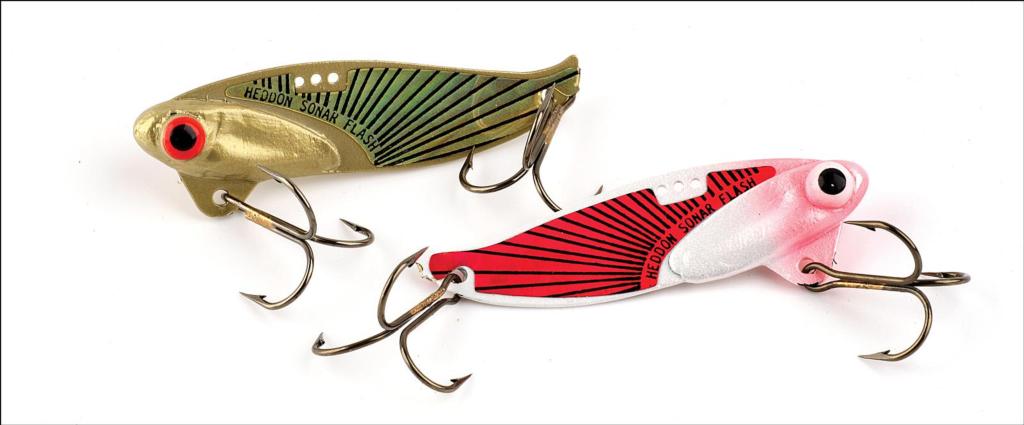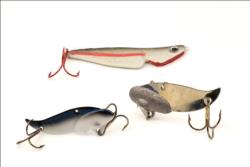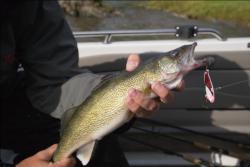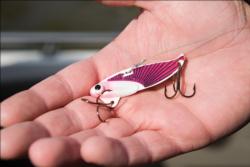The art and science of blade baiting
Blade baits polarizing subject for walleye anglers

————————————–
Editor’s note: This article originally appeared in the October 2006 Walleye Edition issue of FLW Outdoors Magazine. Learn more about FLW Outdoors Magazine and how to subscribe by clicking here.
————————————–
When walleyes are concentrated behind river wing dams or in reservoirs feeding on bait balls near the thermocline, nothing beats a properly presented blade bait for enticing a limit of fish.
Blade baits are a polarizing subject for walleye anglers.
Some anglers don’t have much confidence in blades and don’t fish them. Others swear by their blades with almost religious-like conviction.
This disparity may have to do with where and when anglers are fishing and how they grew up fishing. FLW Walleye Tour pro Dustin Kjelden of Brookings, S.D., for example, resorts to blade baits only in specific situations during specific times of the year.
“I pull out blade baits in the spring and fall if the fish are concentrated,” he said, “and when I can’t get them to bite on a jig.”
For pro Kevin McQuoid of Isle, Minn., blade baits are something he only uses on rivers.
“I’m not a tremendous blade-baiter,” he admited. “Most of the blade-baiting I’ll do is on rivers. My hometown is on Mille Lacs, so I didn’t grow up fishing rivers. I don’t use blade baits as much as other guys do.”
But for other walleye pros, like Washington native Bob Crow and Harris, Minn., pro Mark Courts, blade baiting is an important part of their year-round fish-catching arsenal.
A reaction bait
Courts, age 35, is a Ranger pro who’s been fishing professionally for 12 years. He grew up walleye fishing in Minnesota and Canada, but traveled and fished extensively around the country as he was growing up. He’s taken walleyes up to 9 pounds from the Mississippi River using blade baits. He prefers to fish blades in rivers in the spring and fall; and in reservoirs and lakes in midsummer.
“Blade baits can be real successful on rivers,” he pointed out. “Blades are a reaction bait, for current-oriented fish. I use them to fish current edges, wing dams, along current breaks and in pockets. But you can fish them in reservoirs too, where the baitfish are deep, down where there’s big shad balls and the walleyes are feeding on them. Blade baits look just like a wounded baitfish.”
Courts is quick to point out that blade baits aren’t necessarily a good search bait, however.
“I think a crawler harness, or a live bait presentation, is better when you’re looking for fish, when you’re hand-lining or trolling,” he explained. “You use these other rigs to cover water. But when fish are concentrated behind or off a wing dam, or you want to fish one place thoroughly, drifting with a blade bait over a concentrated spot that’s maybe 300 yards long, that’s when blade baits are really effective.”
Courts favors the Heddon Sonar blade bait, and he keeps a wide selection of colors in his boat.
“Picking a blade bait color is a lot of trial and error,” the pro pointed out. “You want to pick colors that match the baitfish when you can. But in a river situation with dirty water, I’ll try odd, wild colors, something that stands out in the water.”
 To match up with baitfish, Courts deploys chrome and chrome-blue colors. In dirty water or on overcast days and during low-light periods, he’ll resort to red-white, chartreause, firetiger and gold. He also customizes his blades by adding prism tape, or by streaking them with red to mimic wounded baitfish.
To match up with baitfish, Courts deploys chrome and chrome-blue colors. In dirty water or on overcast days and during low-light periods, he’ll resort to red-white, chartreause, firetiger and gold. He also customizes his blades by adding prism tape, or by streaking them with red to mimic wounded baitfish.
Rigging up
In midsummer, Courts uses blade baits in lakes and reservoirs if he’s finding bait balls on his electronics, especially near the thermocline.
“Blade baits are great for fishing suspended walleyes,” he pointed out.
For this application, Courts favors 8- or 10-pound monofilament with some stretch to it.
“That extra stretch gives you a little more time to react,” he said. “But in a river, I’ll use a superline, like FireLine, and a swivel with a foot of fluorocarbon leader. In a river situation, I don’t want any line drag, but in a reservoir I don’t mind it.”
For blading, Courts uses a medium- to heavy-action baitcasting rod, usually a 6- foot, 6 -inch model.
“You don’t want much flop or play in your rod for this presentation,” he explained. “And I like a baitcasting reel with a flipping switch, which makes it easier to stay in contact with the bottom.”
Courts usually customizes the hooks on his blade baits.
“I’ll put on Mustad Triple Grips,” he said, “because of the hooking percentage you get.”
The pro also uses a clevis snap instead of tying directly to the bait.
“When you tie directly, those blades are so dense, they can cut the line easily,” he warned.
Subtle vs. aggressive
Most blade baits have three holes at the top for tying, and each hole imparts a different action to the lure.
“The farther forward you tie, the more subtle the action of the blade,” Courts related. “If you want more vibration, more action, tie to the back hole. I’d say for the average angler, the center hole is about right.”
In rivers, Courts said it’s important to keep the bait in the strike zone, roughly within 6 inches of the bottom.
“I snap-pop them, almost like setting the hook on the upswing,” he said, “bringing it up and letting it flutter back down. But in reservoirs over bait balls, I’ll use a longer, more sweeping-type action and then follow it back down.

“When they hit it, there’s no question they’re there. You set the hook right away, without hesitation. A lot of the fish you’ll catch in rivers when you’re snap-jigging are already hooked if you’re really snapping it good.”
Courts believes in many cases walleyes are following the bait as it drops.
“They’ll sometimes hit it on the drop, but I think they follow it down, and the minute it comes back up, they hit it. They feel that vibration and they want to attack it.”
If Courts knows he’s in an area of concentrated walleyes, but he’s not getting hit, he’ll experiment with his blades.
“I’ll change colors or mess with the action of the blade bait to either offer it more subtly or get more aggressive with it,” he explained.
Courts said a common mistake among weekend anglers is losing focus and getting a little lazy – this is a style of fishing that demands rapt attention.
“You’ve got to give the bait the action it needs to get that quick upward vibration and that flutter fall,” he said.
Blading year-round
Walleye pro Bobby Crow hails from Paterson, Wash., which is right on the walleye-rich Columbia River. For Crow, blade-baiting is an essential component to success.
“I fish them a lot on the Columbia,” he shared. “In the springtime, I’ve taken 15-pounders on blade baits from the Columbia. And lots of 10s, 11s and 12s in the summertime.”
He’s had good results using blades on reservoirs and lakes, too, but he prefers to use them in current situations.
“They really do work most times of the year,” Crow declared. “But when you use a blade bait, you’re looking for a reaction bite. Blade baits let you fish an area a lot better, and you’re in the strike zone a lot longer than you would be with a crankbait.”
Crow is a big believer in using blade baits below dams in the fall.
“There’s usually a slight current then, for about five miles below McNary Dam on the Columbia where I fish. That’s where most of the fish are,” he explained. “They’ll make their fall runs up to the dam, up to the current areas. This time of year, they’ll be deeper, more along the channel edges and in holes where there are current breaks.”
In the winter, Crow fishes reservoirs by casting his blades.
“I like to pitch them up on sandbars and drop them over sand humps,” he said.
Straight vs. cupped
Crow makes his own blade baits, but also likes Heddon Sonars. Some blades feature cupped, rather than straight, blades. He’ll use the cupped style for a more subtle presentation with a much more subtle jigging motion, but prefers straight blades when fish are more aggressive and he wants a more aggressive action.

“Experimenting with colors is essential,” Crow said. “I carry about 25 different colors with me. A lot of the time, I’ll search by pulling crankbaits, and I’ll get a color out of that. Then I’ll match the blade bait color to the crankbait color.”
Like Courts, Crow adds flash tape, mostly scales or flashy prism, to add more visual appeal.
Lift and free-fall
Crow has a special method for fishing his blades: “I think the bite you usually get is on the down stroke. I lift my blades a foot and a half off the bottom and then let them free-fall, but I try to stay in contact with it because you’ll feel the tap. They’ll normally take it when that blade stalls. You’ll feel the hit on the way down.”
Keeping the blade close to the bottom is critical. Crow likes to drop his blades to feel the bottom at first and then he starts jigging.
“But once every 10 or 11 jerks, I’ll drop it back to the bottom to check to see that I’m on or very close to the bottom.”
Crow fishes his blades with 10-pound FireLine tied to a barrel swivel, then uses 24 inches of mono or fluorocarbon leader, and he doesn’t worry too much about staying straight up and down, as you would for vertical jigging a roundhead jig and bait.
When walleyes are concentrated but aren’t being aggressive, Crow changes his jigging technique.
“I’ll go to a little twitch, maybe a 10-inch snap, and I’ll sit there and do that as if it were a spoon, to pick up the fish that aren’t as aggressive,” Crow said. “For the more aggressive fish, I really give it a good jerk to get that reaction bite.”